The Intricate Anatomy of the Foot and Ankle from a Lateral View

As part of our commitment to providing valuable insights into the world of anatomy, Unilevel Studios delves into the comprehensive understanding of foot anatomy from a lateral view. The foot is undoubtedly one of the most fascinating and complex structures in the human body, playing a crucial role in our daily movements and activities.
Key Structures of the Foot and Ankle
When examining the anatomy of the foot and ankle from a lateral view, it's essential to highlight the key structures that contribute to its functionality:
- Bones: The foot and ankle are composed of numerous bones, including the tarsal bones, metatarsal bones, and phalanges. Each bone plays a distinct role in supporting the body and facilitating movement.
- Ligaments: Ligaments are connective tissues that link bones together and provide stability to the foot and ankle. Understanding the ligamentous structures is vital for grasping the biomechanics of the lower extremity.
- Muscles: The intricate network of muscles in the foot and ankle enables us to walk, run, jump, and perform various activities. These muscles work in harmony to ensure proper movement and function.
- Tendons: Tendons connect muscles to bones, allowing for the transmission of forces during movement. They play a crucial role in maintaining the integrity and efficiency of the foot and ankle.
- Nerves and Blood Vessels: The foot and ankle have a rich supply of nerves and blood vessels that are responsible for sensory function and circulation. Understanding their distribution is essential for diagnosing and treating various conditions.
Functional Aspects of Foot Anatomy
From weight-bearing to propulsion, the foot and ankle contribute significantly to our ability to move effectively. The arches of the foot, including the medial longitudinal arch, lateral longitudinal arch, and transverse arch, provide structural support and absorb shock during activities like walking or running.
Additionally, the ankle joint, consisting of the tibia, fibula, and talus bones, is crucial for maintaining balance and stability while allowing for a wide range of movements. The articulation between these bones forms a complex joint that enables dorsiflexion, plantarflexion, inversion, and eversion.
Common Foot and Ankle Conditions
Despite their remarkable resilience, the foot and ankle are susceptible to various conditions and injuries. Some of the common issues affecting this area include:
- Plantar Fasciitis: Inflammation of the plantar fascia, a thick band of tissue that supports the arch of the foot.
- Ankle Sprains: Stretching or tearing of ligaments due to sudden twisting or rolling of the ankle.
- Achilles Tendonitis: Inflammation of the Achilles tendon, the large tendon that connects the calf muscles to the heel bone.
- Bunion: A bony bump that forms on the joint at the base of the big toe, causing pain and deformity.
Understanding the anatomy of the foot and ankle is essential for healthcare professionals, athletes, and individuals seeking to maintain optimal foot health and function. By gaining insights into the intricate structures and mechanisms underlying this vital part of the body, we can better appreciate its significance and take proactive measures to prevent injuries and conditions.
Explore the Fascinating World of Foot Anatomy with Unilevel Studios
Unilevel Studios is a renowned expert in Business and Consumer Services - Website Development, dedicated to providing valuable resources and information on various topics, including anatomy and healthcare. Stay tuned for more insightful content on the human body and its remarkable complexities.









